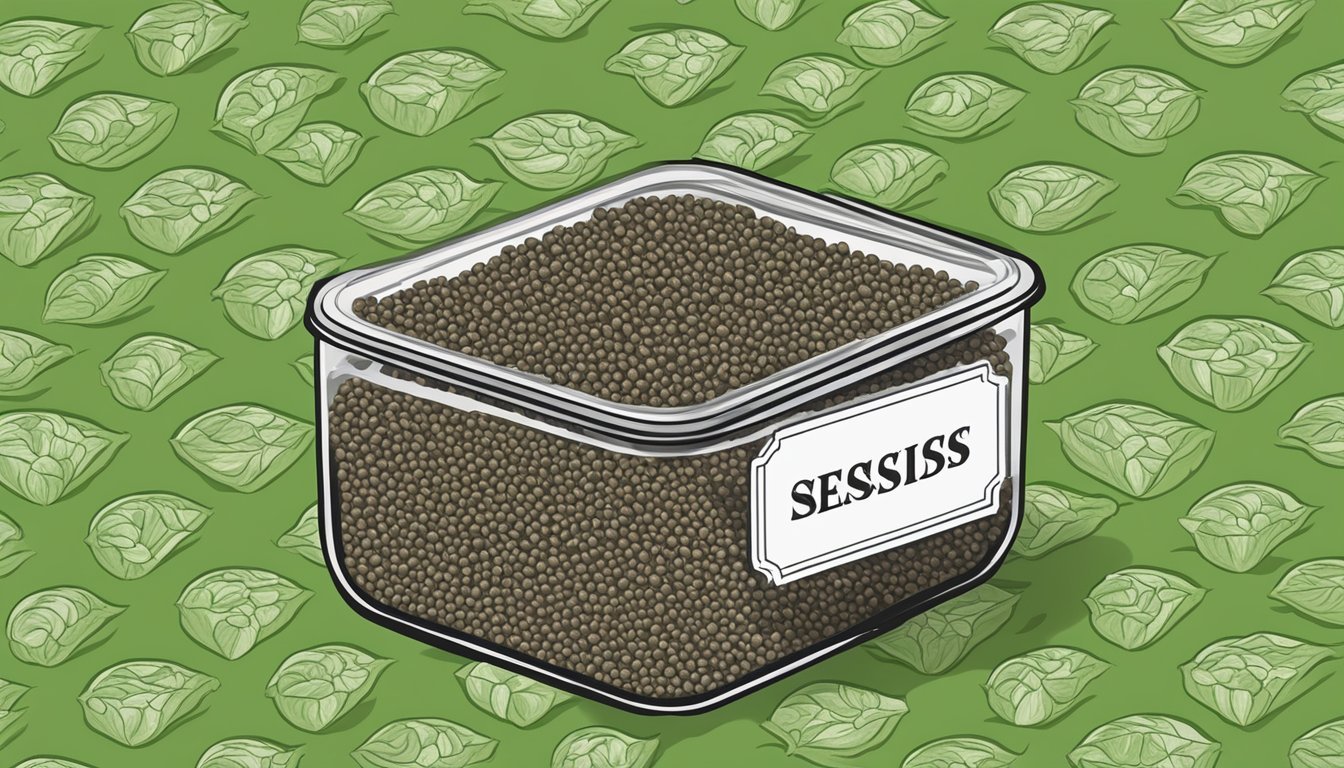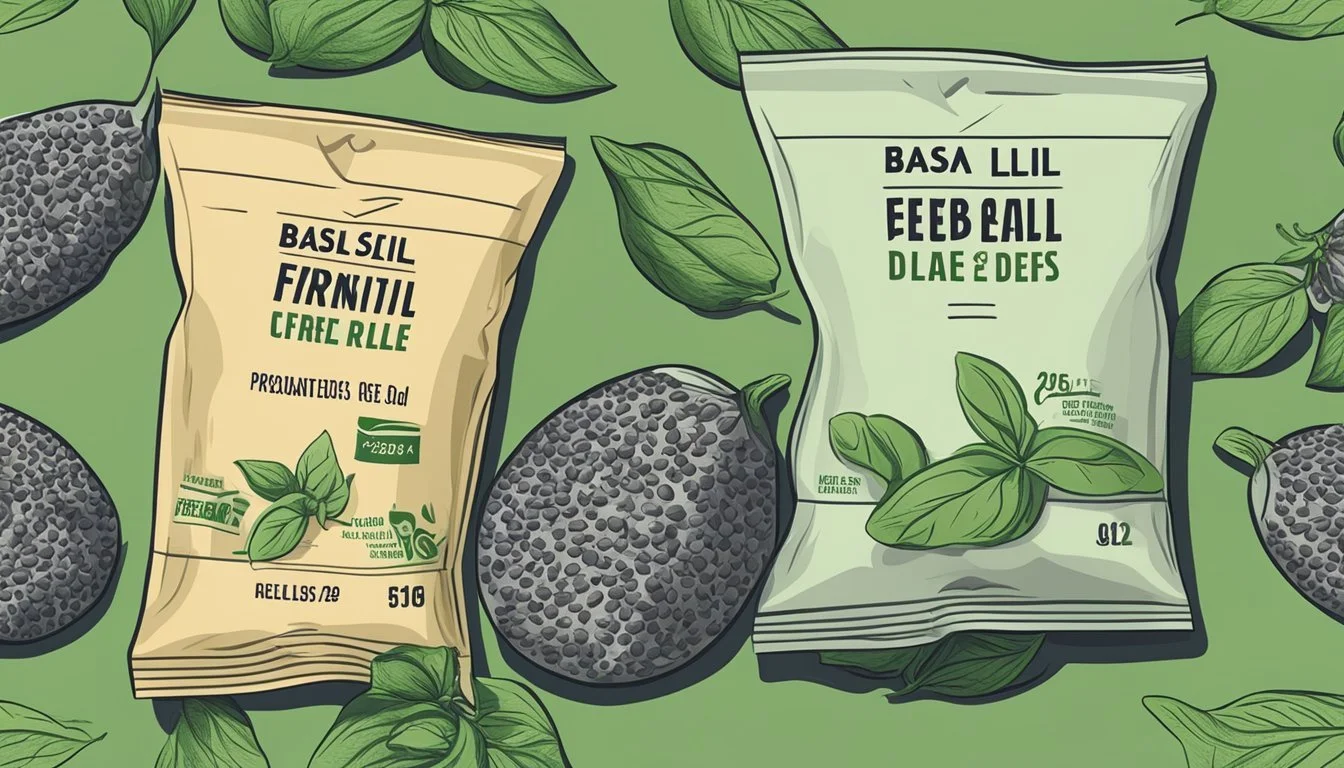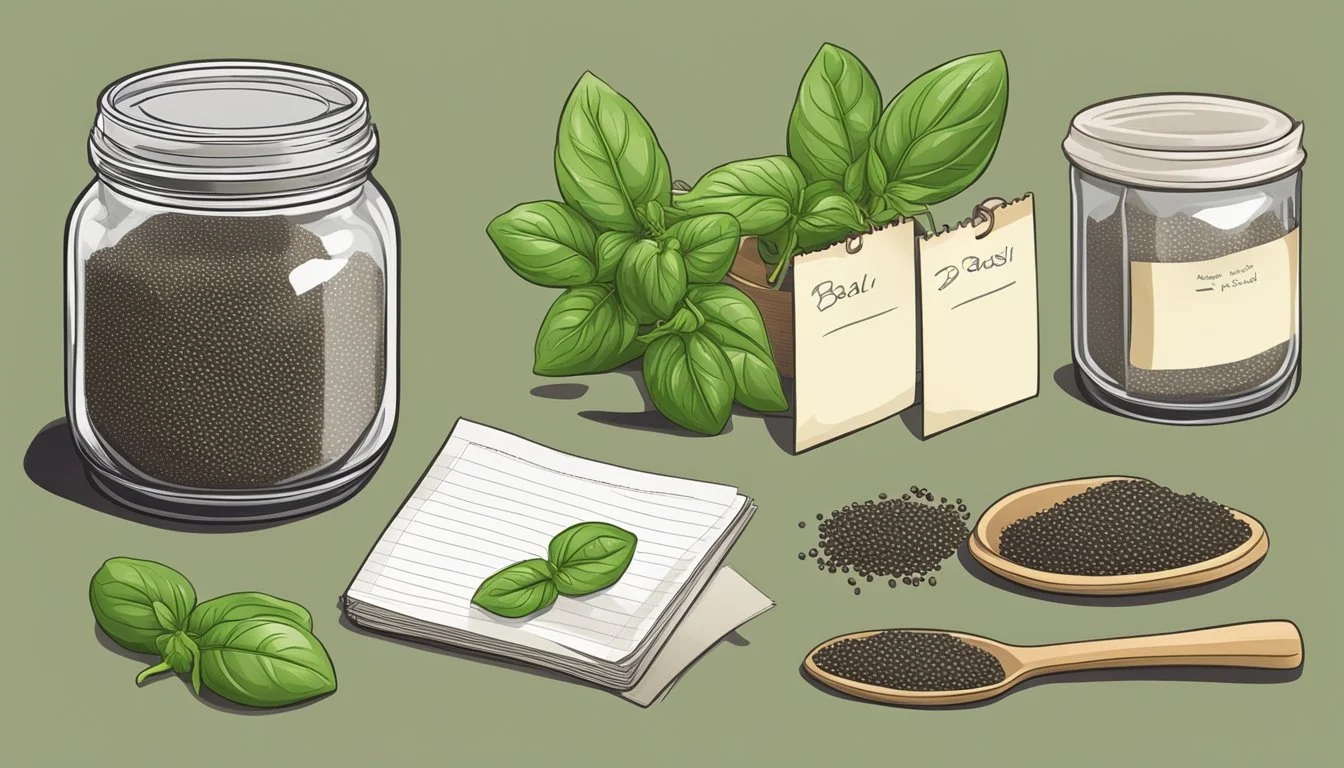How Long Do Basil Seeds Last?
Understanding Seed Viability Periods
Basil (how long does basil last?) seeds have a notable shelf life when stored correctly, remaining viable for up to five years. To ensure longevity, gardeners should employ proper storage techniques, which include keeping the seeds in a dry and dark location. Storing basil seeds in an air-tight container, such as a glass jar, and placing them in the refrigerator can extend their viability, as it provides a consistently dark and cool environment.
Gardeners often label and date basil seeds to track their age, ensuring the oldest seeds are used first. This rotation practice promotes efficient use of the seed supply, preventing wastage due to expiration. It is crucial for those collecting basil seeds to ensure they are completely dried before storage, as any residual moisture can reduce the seeds' viability and lead to spoilage.
Understanding Basil Seeds
Basil seeds serve as the foundation for cultivating a variety of basil plants, each with unique flavors and culinary uses. Quality seeds ensure a strong start for achieving optimal germination and plant vigor.
Species Varieties
Basil comes in several species varieties, each with distinct characteristics. Sweet basil is often used in Italian cuisine and is known for its large, green leaves and classic aroma. Thai basil offers a spicier flavor profile, with sturdy leaves and purple stems. Lemon basil, as the name implies, infuses dishes with a citrusy essence. The seeds of each variety might differ slightly in appearance, but generally, basil seeds are small and range from dark brown to black.
Seed Composition and Quality
Basil seeds should be plump and have a uniform color indicative of good quality. The integrity and vigor of seeds are crucial for successful germination. Higher quality seeds tend to produce more robust seedlings and, ultimately, healthier basil plants.
Germination Process
The germination process for basil seeds involves sowing the seeds in soil and ensuring they receive consistent moisture and warmth. Optimal germination occurs when seeds are planted at a depth of about a quarter of an inch and kept in conditions with temperatures between 70-80°F (21-27°C). Basil seeds typically germinate within 5 to 10 days when provided with adequate sunlight and humidity.
Basil Lifecycle
Basil is an annual herb, thriving in the warmth of the spring and summer months. The lifecycle begins with germination and progresses to seedling growth. It then reaches maturity where it will eventually flower, drawing in beneficial insects. Post-flowering, basil plants will set seeds for the next season before completing their lifecycle.
Optimal Growing Conditions
Basil plants require optimal growing conditions to flourish, including plenty of direct sunlight and moderate moisture. They fare best in temperatures above 50°F (10°C) and should be shielded from cold drafts and frosts. Adequate spacing between plants ensures proper air circulation and can prevent many common issues with moisture and pests.
Health and Nutritional Benefits
Basil seeds, like the leaves of basil plants, are known for their health benefits. They add not only a burst of flavor and aroma to dishes but also contain compounds that can attract beneficial insects to the garden. Additionally, basil offers nutritional value with a variety of vitamins and minerals, and its essential oils are appreciated for their potential therapeutic properties.
Storing Basil Seeds
Proper storage is vital for maintaining the viability of basil seeds, with factors like moisture, temperature, and storage method significantly impacting their longevity.
Ideal Storage Conditions
The ideal storage conditions for basil seeds involve keeping them in a dry, cool environment away from direct sunlight. Storing the seeds in a place where the temperature is consistently between 10°C and 15°C helps in prolonging their shelf life. Relative humidity should be low to prevent any moisture from compromising the seed quality.
Storage Duration
Basil seeds, if stored properly, can retain viability for up to five years. The storage duration hinges on the initial quality of the seed and adherence to optimal storage practices. Regularly rotating the seed stock ensures that older seeds are used first, preventing any from staying in storage beyond their peak viability period.
Avoiding Common Storage Issues
To avoid common storage issues such as mold and loss of viability, seeds should be stored:
In airtight containers such as glass jars with tight-fitting lids.
With desiccants like silica gel packets to control humidity.
In environments free from drastic temperature fluctuations.
It is important to ensure that the basil seeds are completely dry before storage; any residual moisture can lead to mold growth and a decrease in seed quality.
Signs of Seed Deterioration
Signs that basil seeds may be deteriorating include:
A change in color or appearance, such as dark spots or mildew.
An off or musty odor, which indicates mold or moisture issues.
A lack of germination when seeds are sown, suggesting a loss of viability.
Visual inspection and a germination test are reliable methods to assess the condition of stored seeds. Seeds that display any of these deterioration signs should not be sown.
Planting and Care of Basil
The vitality of basil plants hinges on proper planting practices and consistent care throughout their growth. Gardeners will find success by paying close attention to the seed sowing process, ensuring adequate light and water, and safeguarding against common pests and diseases.
Sowing and Transplanting
For optimal germination, basil seeds should be sown indoors 6-8 weeks before the last expected frost. Seed packets provide vital information on the depth and spacing; typically, basil seeds are sown 1/4 inch deep and spaced adequately to prevent overcrowding. Upon reaching 2-3 inches in height with true leaves, they are ready to transplant outdoors, ideally spaced 12-18 inches apart to ensure sufficient access to nutrients and air circulation, which is pivotal for robust growth.
Watering and Light Requirements
Basil requires consistent moisture but detests waterlogged soil, so it's crucial to strike a balance. Watering should be done when the soil feels dry to the touch; being cautious not to overwater is key. Basil thrives with at least 6 hours of direct sunlight a day, which can be mimicked with a grow light if growing indoors. A home gardener should ensure that the ambient conditions promote healthy growth, whether indoors or outdoors.
Dealing with Common Basil Pests and Diseases
Basil can be afflicted by a variety of pests and diseases; common adversaries include aphids and spider mites. A diligent gardener can mitigate these threats through natural deterrents and regular inspection. Diseases like downy mildew, characterized by yellowing leaves and a fuzzy underside, also pose a threat. Ensuring good air flow around the plants and reduced leaf moisture can help keep such diseases at bay.
Harvesting and Using Basil
Basil is revered for its aromatic leaves that are a staple in cuisines worldwide. Successful harvesting and usage demand attention to timing and technique.
When and How to Harvest
To capture the best flavor, basil leaves should be harvested just before the plant flowers. The ideal time is in the morning when the oils in the leaves, that contribute to the herb's aromatic nature, are most concentrated. Leaves can be snipped from the top with scissors or pinched with fingers, allowing the plant to continue growing.
From Garden to Kitchen
Fresh basil leaves can enhance any dish, from salads to sauces. For a classic pesto, blend basil with pine nuts, garlic, Parmesan cheese, and olive oil. Fresh leaves can also be stored in the refrigerator in a sealed container with a moist paper towel for short-term use.
Seed Saving and Propagation
Basil seeds can be saved by allowing the flowers to brown and then harvesting the seed heads. Once dry, seeds should be stored in a container away from direct sunlight. Basil can also be propagated through cuttings, taking a four-inch section and removing the lower leaves before planting.
Companion Planting
Basil's aromatic quality makes it an excellent companion to a variety of annual flowers and vegetables such as tomatoes, peppers, beans, carrots, lettuce, onions, parsnips, and peas, as it is believed to enhance flavor and deter pests.
Other Culinary Herbs
In a garden, basil grows well with other herbs including chives, cilantro, oregano, parsley, and sage. They add a range of flavors to a cook's palate and share similar growing requirements, which simplifies garden management.
Additional Tips and Guidelines
For gardeners seeking to extend the viability of basil seeds and ensure a lush basil harvest, understanding the nuances of creating an optimal growing environment, consistent pruning, and leveraging educational resources is essential. These practices not only influence seed longevity but also the overall health and productivity of the basil plant.
Creating an Optimal Growing Environment
To maximize the growth and eventual seed production of basil plants, gardeners should provide a warm, well-lit space with ample sunlight—ideally six to eight hours of direct light each day. Soil should be fertile, well-drained, and kept slightly moist. Regular monitoring for proper pH levels, which should be between 6.0 and 7.0, will also contribute to robust basil plants.
Pruning and Maintenance
Pruning is a key factor in maintaining a vigorous basil plant, which in turn supports the development of quality seeds. By regularly removing the tips of the plant, one encourages bushier growth and prevents early flowering, which can divert energy away from seed production. Pruning should be done with clean, sharp tools to minimize stress to the plant.
Educational Gardening Resources
Gardeners are encouraged to subscribe to reputable gardening newsletters and publications to stay informed about the latest techniques and findings in basil cultivation. These resources can provide timely information on topics ranging from pest management to advanced pruning techniques, helping gardeners to address challenges and improve their basil-growing practices.
Basil Seeds Glossary and Terms
This section covers essential terminology related to basil seed life span, handling, and growth processes. It is designed to provide gardeners with a clear understanding of the key terms they may encounter when working with basil seeds.
Seed Related Terminology
Glossary: A compilation of terms and definitions related to a specific subject, such as basil seeds.
Germinate/Germination: The process by which a seed begins to grow and put out shoots after a period of dormancy. Basil seeds typically germinate within 7-10 days after sowing.
Seedlings: Young plants that develop from the germinated seed. Basil seedlings are ready for transplanting a few weeks after germination.
Transplant: The act of moving a plant from one growing location to another, such as from a nursery to a garden bed.
Sowing: To scatter or place seeds in soil or another growing medium in order for them to germinate and grow.
Nursery: A place where young plants and seedlings are cultivated until they are ready to be transplanted.
Dry Seeds: Seeds with low moisture content, suitable for storage. Properly stored dry basil seeds can remain viable for several years.
Pruning: The selective removal of parts of a plant, such as branches, buds, or roots, to improve or maintain the plant's health and promote more robust growth. Pruning is not typically associated with growing basil from seed but becomes important later in the plant's life cycle.
Botany and Plant Biology
Compost Pile: A collection of organic waste that decomposes and is used to enrich soil. Basil seedlings benefit from being planted in soil amended with compost.
Chaff: The husks of corn or other seed separated by winnowing or threshing. During seed harvest, chaff is discarded to isolate the seeds for storage or sowing.
Frequently Asked Questions
The longevity and successful growth of basil from seeds hinge on understanding their shelf life, proper storage conditions, and germination techniques. This section provides answers to common questions, offering gardeners insight into maintaining seed viability and nurturing healthy basil plants.
Shelf Life Concerns
Basil seeds have a significant shelf life, remaining viable for up to 5 years if stored correctly. To ensure maximum longevity, one should store basil seeds in a cool, dry place, preferably in a glass jar to prevent moisture exposure which can diminish their vigor.
Improving Germination Success
To boost germination success, basil seeds should be kept at temperatures between 70-80°F (21-27°C), which is the ideal range for germination. Pre-soaking the seeds before planting can also enhance germination rates. A moist paper towel can facilitate the soaking process.
Purchasing and Selecting Quality Seeds
When selecting basil seeds, quality is paramount. Look for reputable seed suppliers that offer black seeds, typically an indication of freshness and high quality. Fresh seeds tend to have better vigor and a higher germination rate, especially true for annual herbs like basil.
Troubleshooting Plant Growth Issues
If basil seedlings are exhibiting growth issues, check for common problems such as inadequate light, water, or temperatures outside the optimal range. One should also evaluate the quality of the soil and ensure it provides adequate drainage and nutrients.
Gardening in Different Climate Zones
Gardening in varying climate zones requires an understanding of the local growing season. Basil thrives in warm conditions, so in cooler climates, one may need to start seeds indoors in spring to transplant after the risk of frost has passed. Conversely, in hotter climates, basil can often be direct-seeded in early summer.
Conclusion
Basil seeds exhibit remarkable longevity, capable of remaining viable for up to 5 years when stored properly. Gardeners should ensure these seeds are placed in an airtight container and kept in a cool, dry environment, such as a refrigerator or freezer, to preserve their germination potential.
The act of harvesting basil seeds requires attentiveness to timing—typically when the flower heads have browned and seeds are fully mature. After collecting the seeds, they must be carefully dried to prevent mold, then sealed away from moisture and light.
For those inclined towards growing basil, beginning with healthy seeds is crucial. One must select a suitable container and soil type to support the growth of basil from seed to full plant. Regular care and appropriate sun exposure can extend the life of basil plants, particularly in warmer climates where conditions may permit year-round cultivation.
In summary:
Storage: Airtight, cool, dry place away from light.
Harvesting: When flower heads are brown and seeds mature.
Drying: Essential to prevent spoilage before storage.
Sowing: Requires suitable soil and container for optimal growth.
Growing: Sturdy plants with proper care can last longer, especially indoors or in favorable climates.
Given these guidelines, gardeners can confidently manage their basil seed supply, ensuring a bounty of this beloved herb through successive growing seasons.






